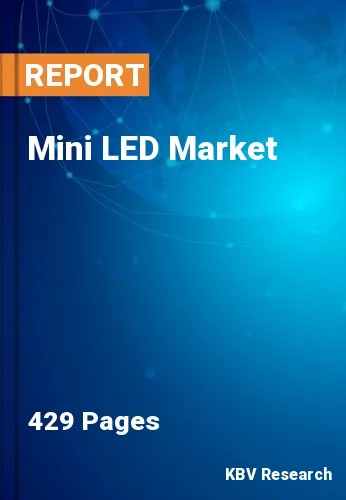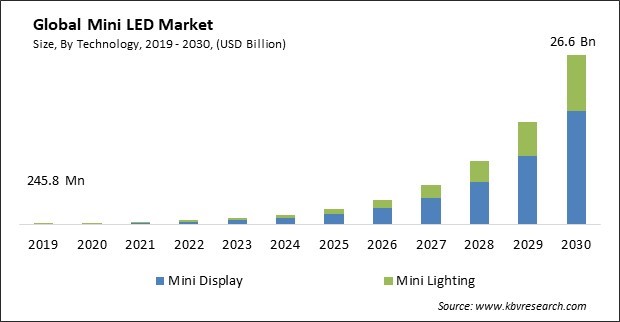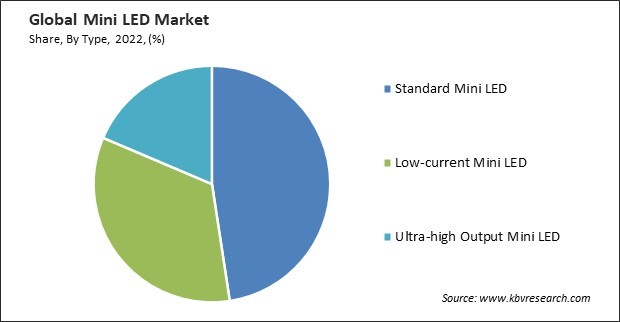
The Global Mini LED Market size is expected to reach $26.6 billion by 2030, rising at a market growth of 58.2% CAGR during the forecast period. In the year 2022, the market attained a volume of 1,20,459.0 thousand units, experiencing a growth of 44.3% (2019-2022).
Mini LED displays can provide enhanced brightness, better contrast ratios, and improved color accuracy compared to traditional LED displays. This results in a better overall viewing experience, especially when watching videos, playing games, or viewing photos on a mobile phone. Consequently, the mobile phone segment would generate approximately 22.2% share of the market by 2030. Mini LED technology allows for thinner display panels, contributing to slimmer and more lightweight mobile phone designs. This is important for users who prioritize sleek and portable devices. Mini LED displays are well-suited for AR and VR applications on mobile phones, offering high-resolution, low latency displays for immersive experiences. Some of the factors affecting the market are Improved display performance by mini LEDS, Technology developments and cost savings, and Competition from other types of display technologies.

Consumers consistently seek displays with better brightness, contrast, color accuracy, and resolution. Technologies like OLED, mini-LED, and quantum dot have been developed to meet these demands, resulting in stunning picture quality and more immersive viewing experiences. HDR technology, which enhances the range of brightness and color levels a display can reproduce, has become a standard feature in many displays. It has performed a crucial role in enhancing viewers' visual experience by delivering more realistic images and videos. Moreover, Mini LED technology involves using much smaller LEDs than traditional LEDs. Advances in manufacturing processes have enabled the production of these tiny LEDs with high precision. Mini LEDs allow for more precise local dimming with densely packed LED zones. This technology results in better contrast ratios and enhanced display quality, making it attractive for high-end displays. As technology evolves and production costs decrease, it will likely see even broader adoption and further market growth.
However, Mini LED displays face competition from established display technologies such as OLED (Organic Light-Emitting Diode), microLED, and QLED (Quantum Dot Light Emitting Diode). These technologies offer unique advantages, including self-emissive properties and superior contrast ratios, which can make it challenging for mini-LED displays to compete in specific segments. OLED displays are known for their self-emissive properties, meaning each pixel emits light. This results in true blacks, infinite contrast ratios, and thinner form factors. OLEDs have become the gold standard for premium TVs and mobile device displays. Due to such factors, the market growth will decline.
On the basis of technology, the market is segmented into mini display and mini lighting. In 2022, the mini display segment dominated the market with the maximum revenue share. Mini displays are identified by their small dimensions and advanced technological capabilities. Regarding image reliability, mini-LED displays have surpassed traditional LED displays. Multiple tiny LEDs allow for more precise local dimming, greater contrast levels, and enhanced High Dynamic Range (HDR) performance. The improved image quality of microdisplays provides an immersive and engaging viewing experience for consumers. Mini LED displays may achieve greater color accuracy and wider color gamuts, which makes them suitable for applications requiring high color fidelity, such as professional video and photo editing.
By type, the market is fragmented into standard mini-LED, low-current mini-LED, and ultra-high output mini-LED. In 2022, the standard mini-LED segment held the highest revenue share in the market. Standard mini-LEDs are extensively used in various applications owing to their energy efficiency, small size, and long lifespan compared to incandescent and fluorescent lights. As mini-LEDs are compact, they are used as creative and space-saving technology in various applications. They have become popular as a lighting option for home and commercial applications. They are designed to be energy-efficient, providing superior display quality without significantly increasing power consumption.

Under consumer electronics type, the market is further segmented into mobile phone, laptops/ notebooks, and television. In 2022, the television segment witnessed the largest revenue share in the mini-LED market. Mini LEDs are known for their ability to improve display quality significantly. They offer enhanced brightness, better contrast ratios, and improved color accuracy than traditional LED-backlit LCDs. This results in a more immersive and vibrant viewing experience. Mini LED TVs can deliver stunning HDR performance with increased brightness levels, better color accuracy, and improved handling of highlights and shadows. This makes them ideal for watching HDR content, such as movies and streaming services.
Based on application, the market is classified into consumer electronics, automotive, and others. The automotive segment recorded a remarkable revenue share in the market in 2022. Mini LED is employed in modern automobile headlight systems to boost brightness, beam control, and precision adaptive lighting. The compact size enables more precise pixelation and individual control, offering adaptive lighting that responds to changing driving conditions, such as approaching traffic or road curves. Mini LEDs are used in daytime running lights to provide energy-efficient, long-lasting, and distinctive lighting systems, improving vehicle visibility throughout the day.
| Report Attribute | Details |
|---|---|
| Market size value in 2022 | USD 447.8 Million |
| Market size forecast in 2030 | USD 26.6 Billion |
| Base Year | 2022 |
| Historical Period | 2019 to 2021 |
| Forecast Period | 2023 to 2030 |
| Revenue Growth Rate | CAGR of 58.2% from 2023 to 2030 |
| Number of Pages | 429 |
| Number of Table | 850 |
| Quantitative Data | Volume in thousand Units, Revenue in USD Million, and CAGR from 2019 to 2030 |
| Report coverage | Market Trends, Revenue Estimation and Forecast, Segmentation Analysis, Regional and Country Breakdown, Companies Strategic Developments, Company Profiling |
| Segments covered | Type, Technology, Application, Region |
| Country scope | US, Canada, Mexico, Germany, UK, France, Russia, Spain, Italy, China, Japan, India, South Korea, Singapore, Malaysia, Brazil, Argentina, UAE, Saudi Arabia, South Africa, Nigeria |
| Growth Drivers |
|
| Restraints |
|
Region wise, the market is analyzed across North America, Europe, Asia Pacific, and LAMEA. The LAMEA region acquired a substantial revenue share in the market in 2022. The regional market advancement is attributed to the expanding use of LED screens in the military and automotive industries and the Internet of Things, which is expected to drive up demand for laptops, projectors, smartwatches, and smartphones. Owing to the installation of LED lightbulbs across the Middle East and Africa stores, the mini-LED market is expected to grow in this region.
Free Valuable Insights: Global Mini LED Market size to reach USD 26.6 Billion by 2030
The market research report covers the analysis of key stakeholders of the market. Key companies profiled in the report include AUO Corporation, Ennostar Inc., Everlight Electronics Co., Ltd., Harvatek Corporation, Japan Display, Inc., Tianma Microelectronics Co., Ltd., ams-OSRAM AG, Hon Hai Precision Industry Co. Ltd, Suzhou Dongshan Precision Manufacturing Co., Ltd., SANAN Optoelectronics Co., Ltd.
ByTechnology (Volume, Thousand Units, USD Million, 2019-2030)
By Application (Volume, Thousand Units, USD Million, 2019-2030)
By Type (Volume, Thousand Units, USD Million, 2019-2030)
By Geography (Volume, Thousand Units, USD Million, 2019-2030)
This Market size is expected to reach $26.6 billion by 2030.
Improved display performance by mini LEDS are driving the Market in coming years, however, Competition from other types of display technologies restraints the growth of the Market.
AUO Corporation, Ennostar Inc., Everlight Electronics Co., Ltd., Harvatek Corporation, Japan Display, Inc., Tianma Microelectronics Co., Ltd., ams-OSRAM AG, Hon Hai Precision Industry Co. Ltd, Suzhou Dongshan Precision Manufacturing Co., Ltd., SANAN Optoelectronics Co., Ltd.
In the year 2022, the market attained a volume of 1,20,459.0 thousand units, experiencing a growth of 44.3% (2019-2022).
The Consumer Electronics segment is leading the the Market by Application in 2022; thereby, achieving a market value of $12.7 billion by 2030.
The North America region dominated the Market by Region in 2022, and would continue to be a dominant market till 2030; thereby, achieving a market value of $9.7 billion by 2030, growing at a CAGR of 57.1 % during the forecast period.
Our team of dedicated experts can provide you with attractive expansion opportunities for your business.
